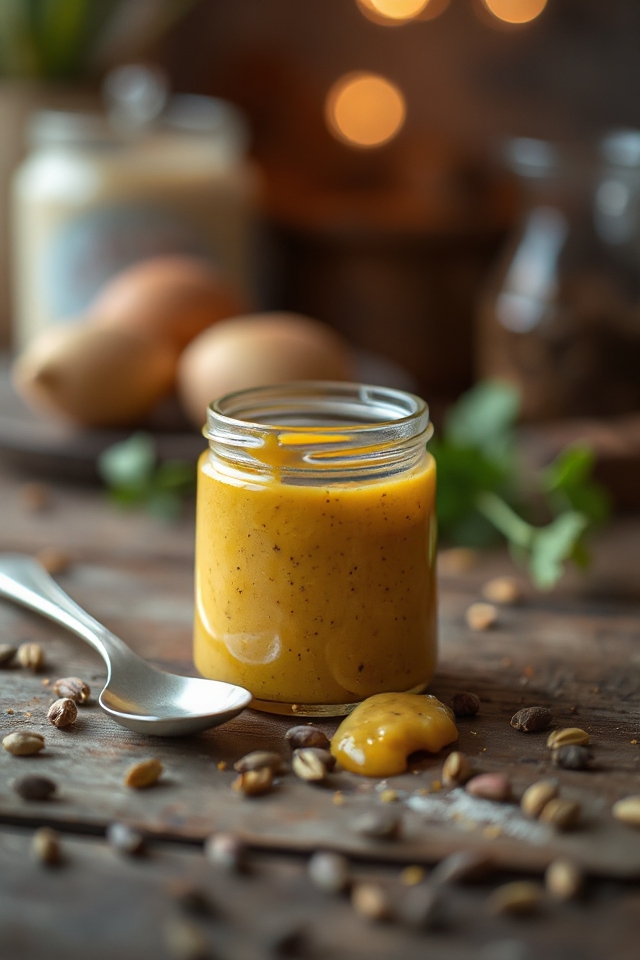Why You’ll Love This Homemade Mustard Recipe
You’ll absolutely love this homemade mustard recipe for its simplicity and rich flavor.
I mean, who doesn’t enjoy a zesty condiment that elevates sandwiches and dips? Making mustard at home lets you control the flavors, ensuring it’s just how you like it.
Plus, it’s a fun kitchen project that doesn’t take much time. Once you taste that fresh, tangy goodness, you won’t want to go back to store-bought versions.
It’s incredibly satisfying to know you’ve crafted something delicious from scratch. Trust me, your taste buds will thank you, and your meals will never be the same again!
Ingredients of Homemade Mustard
When it comes to making homemade mustard, the ingredients are super simple but pack a punch of flavor. Getting your hands on the right components is the first step toward crafting that golden, zesty spread that can turn a plain sandwich into a flavor explosion.
Plus, you probably already have a few of these items in your pantry, so you won’t break the bank or make an extra trip to the store. How great is that? Let’s explore what you need to whip up a batch of this delicious condiment.
Ingredients for Homemade Mustard:
- 1/2 cup dry mustard (or 1 cup if you’re feeling adventurous)
- 1/2 cup cider vinegar (or 1 cup for the bold ones)
- 1/2 cup water (you can use more or less depending on your preferred consistency)
- 2 egg yolks (or 2 if you double the recipe)
- 1 cup sugar (because who doesn’t love a touch of sweetness?)
- 3 teaspoons cornstarch (or 2 teaspoons for the larger batch)
Now, before you rush off to gather everything, let’s talk about some fun considerations for these ingredients.
First off, dry mustard is the star of the show, so picking a good quality brand can really elevate your mustard game. You can also play around with the type of vinegar—apple cider gives it a nice tang, but white vinegar or even wine vinegar can create a different flavor profile.
And don’t forget about sugar; you can tweak the amount based on how sweet you like your mustard. If you’re feeling daring, try adding a dash of spices or herbs for an extra kick!
Just remember, this is your mustard, so make it uniquely yours. Who knows? You might just create a masterpiece that has your friends begging for the recipe.
How to Make Homemade Mustard

Making homemade mustard isn’t just about mixing ingredients; it’s an adventure in flavor. So, grab your apron and let’s get started!
First off, you’ll want to take 1/2 cup of dry mustard and blend it with 1/2 cup of cider vinegar in a bowl. This is where the magic begins—allowing the mustard to dissolve into the vinegar creates that zesty base we all love. Don’t rush this part; let it sit for a few minutes to really develop those flavors. While you wait, you can take a moment to admire how vibrant the mustard looks. Seriously, it’s like a little jar of sunshine waiting to happen!
Next, grab a saucepan and a double boiler if you have one. If not, don’t worry; a regular saucepan will work—just keep an eye on it. In your double boiler, combine the mustard-vinegar mixture with 1/2 cup of water, 2 egg yolks, 1 cup of sugar, and 3 teaspoons of cornstarch.
Now it’s time to get stirring. You’ll want to cook this concoction over simmering water, constantly stirring for about 10 minutes or until it thickens to your desired consistency. You’re looking for a thick, spreadable mustard—something you can slather on a sandwich without it dripping everywhere. And if you happen to get a little splatter on your shirt, consider it a badge of honor for your culinary commitment.
Once your mustard reaches that beautiful thick texture, it’s time to transfer it into containers. Pour it carefully, because nobody wants a mustard disaster on their kitchen counter. Let it cool down for a bit, then cover it and pop it in the fridge.
Homemade Mustard Substitutions & Variations
Exploring homemade mustard opens up a world of delicious substitutions and variations to suit your taste.
For a milder flavor, try using white wine vinegar instead of cider vinegar. If you’re feeling adventurous, add honey or maple syrup for a touch of sweetness.
Want some heat? Incorporate horseradish or a pinch of cayenne pepper. You can also experiment with different types of mustard seeds—yellow, brown, or black—for unique textures and flavors.
Finally, consider adding herbs like dill or garlic for an extra twist. Personalizing your mustard is half the fun, so don’t hesitate to get creative!
What to Serve with Homemade Mustard
What foods pair perfectly with homemade mustard? I love serving it alongside grilled sausages and hot dogs; the tangy kick enhances their flavors beautifully.
It’s also fantastic with roasted meats like chicken or pork, adding a zesty touch. I often spread it on sandwiches, especially with turkey or ham, for that extra zing.
Don’t forget about pretzels—dipping them in homemade mustard is a must!
For a delightful appetizer, try it with cheese boards, where the mustard complements various cheeses.
Finally, it’s great in salad dressings, giving a unique twist to my favorite salads. Enjoy experimenting with these pairings!
Additional Tips & Notes
While creating your homemade mustard, keep in mind a few tips to enhance the flavor and texture.
First, let the mustard sit for at least 24 hours before using it; this allows the flavors to meld beautifully. If you prefer a smoother texture, feel free to blend it further.
For a kick, experiment by adding spices like garlic powder or smoked paprika. Remember to adjust the sweetness to your liking—more sugar creates a sweeter mustard.
Finally, store it in an airtight container in the fridge, and it’ll last for several weeks, ensuring you always have delicious mustard on hand!